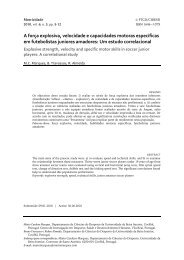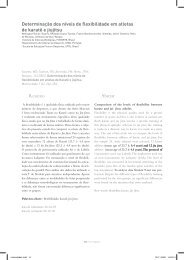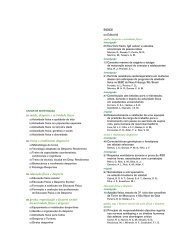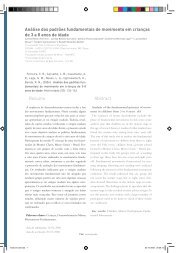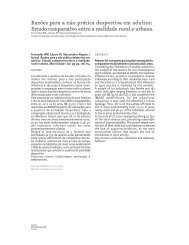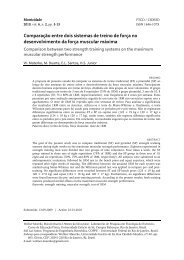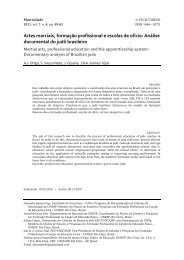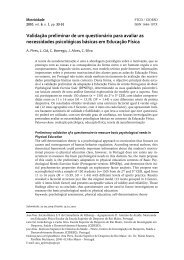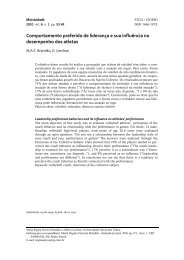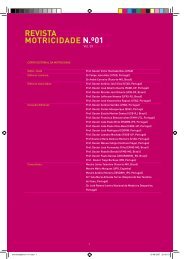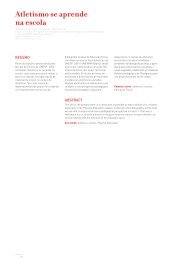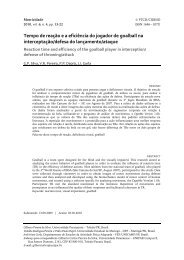revista motricidade
revista motricidade
revista motricidade
- No tags were found...
Create successful ePaper yourself
Turn your PDF publications into a flip-book with our unique Google optimized e-Paper software.
68 | A. Pereira, A.J. Silva, A.M. Costa, E.B. Almeida, M.C. Marques<br />
Over several decades many researchers have<br />
recognized numerous physiological characteristics<br />
associated with sports performance,<br />
describing the athlete’s typical response to<br />
training. Indeed, regular exercise induces<br />
significant effects on different biological<br />
structures and functions, which leads to<br />
specific adaptations in strength and muscular<br />
endurance (Maughan, 2005; Timmons, 2011).<br />
However, while some individuals have a minor<br />
response to exercise others show remarkable<br />
adaptations far beyond the expected typify<br />
response. From this perspective, the expected<br />
average adaptation value (e.g., anaerobic<br />
power) masks the true extent of individual<br />
variability in a particular phenotype (Roth,<br />
2008). Whether they are recreational or elite<br />
athletes, knowing how each subject is going to<br />
adapt would enable the application of<br />
exercise/training programs highly individualized.<br />
Moreover, “... greater knowledge of the<br />
mechanisms and interaction of exercise-induced<br />
adaptive pathways in skeletal muscle is important for<br />
our understanding of the etiology of disease,<br />
maintenance of metabolic and functional capacity<br />
with aging, and training for athletic performance”<br />
(Coffey & Hawley, 2007, p. 9).<br />
Because genetic factors are thought to<br />
determine 20–80% of the variation in a<br />
number of traits important to athletic<br />
performance (MacArthur & North, 2007;<br />
McCauley, Mastana, & Folland, 2010), the<br />
contribution of molecular biology technologies<br />
have been crucial over the past years to the<br />
progress of knowledge in this area. With effect,<br />
the Human Gene Map for Performance and<br />
Health-related Fitness Phenotypes reports<br />
several genes and quantitative trait loci shown<br />
to be related to physical performance of healthrelated<br />
phenotypes (Bray et al., 2009). One of<br />
the polymorphisms within specific gene loci<br />
that clearly emerges as a potentially candidate<br />
that could explain part of the performance<br />
variation particularly in sports requiring high<br />
levels of power and speed is the alpha-actinin-3<br />
(ACTN3) R577X polymorphism (Berman &<br />
North, 2010). Despite the apparent low feature<br />
of ACTN3 in humans, several genotype screens<br />
in high-level athletes from various sporting<br />
disciplines noted that Caucasian sprint/power<br />
athletes showed a very low frequency of<br />
homozygosity for the ACTN3 premature stop<br />
codon 577X mutation. Also, the frequency of<br />
the 577XX genotype appears to be relatively<br />
higher in Caucasian elite endurance athletes.<br />
In other populations, ACTN3 seem to<br />
influence strength and functional capabilities<br />
at baseline (Moran et al., 2007; Walsh, Liu,<br />
Metter, Ferrucci, & Roth, 2008) and in<br />
response to strength training (Clarkson et al.,<br />
2005).<br />
In brief, this article reviews the current<br />
state of knowledge regarding the genetic<br />
effects of the ACTN3 R577X polymorphism on<br />
sports performance traits, such as aerobic<br />
endurance, muscular strength and power.<br />
Alpha-actinin-3 (R577 Allele) as a possible<br />
candidate gene for sports performance<br />
The α-actinins are a family of actin-binding<br />
proteins that play a key role in the<br />
maintenance and regulation of the<br />
cytoskeleton (Blanchard, Ohanian, & Critchley,<br />
1989). In skeletal muscle, both family<br />
members alpha-actinin 2 and alpha-actinin 3<br />
are major components of sarcomeric Z-lines.<br />
They are responsible from stabilizing the<br />
contractile structure (McArthur & North,<br />
2004), where they function to anchor actioncontaining<br />
thin filaments in a constitutive<br />
manner (Mills et al., 2001). Several binding<br />
studies suggest that alpha-actinins also play a<br />
role in the interaction between the sarcomere<br />
cytoskeleton and the muscle membrane<br />
(Hance, Fu, Watkins, Beggs, & Michalak,<br />
1999; Otey, Vasquez, Burridge, & Erickson,<br />
1993) and in the regulation of myofiber differentiation<br />
and/or contraction (North, 2008).<br />
The expression pattern of these two<br />
humans alpha-actinins has diverged during<br />
evolution (Macarthur & North, 2004): alphaactinin<br />
2 (ACTN2) is expressed in all heart and<br />
oxidative skeletal muscle fibers while<br />
expression of alpha-actinin 3 (ACTN3) is



